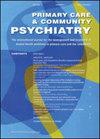Enhanced treatment for depression in primary care : first year results on compliance, self-efficacy, the use of antidepressants and contacts with the primary care physician
引用次数: 24
Abstract
Objective: We describe the contents and feasibility of the Depression Recurrence Prevention (DRP)-Program, a structured psycho-educational self-management intervention based on an ongoing relationship between patient, prevention specialist and primary care physician. The DRP-Program consisted of three individual face-to-face sessions with a trained prevention specialist, followed by four telephone contacts per year. Methods: 267 primary care patients with a DSM-lV diagnosis of major depression were included and randomly assigned to care as usual (CAU; n = 72) or enhanced care (n = 195), which consisted of the DRP-Program either by itself or in combination with a psychiatric consultation or brief cognitive behavioral therapy. Result: DRP-program participation rates were high, both in the initial phase (92%) as during the first year of follow-up (95%) and patient evaluations were generally positive. Enhanced care patients were significantly more satisfied with effects of the depression care than CAU patients after three months. Perceived self-efficacy in dealing with depression was mostly similar in the four treatment groups. The use of antidepressants was lowest throughout the year in patients assigned to CBT plus DRP, who also kept less in touch with their PCP. Conclusion: The DRP-program proved to be feasible and appreciated.在初级保健中加强对抑郁症的治疗:第一年依从性、自我效能、抗抑郁药的使用以及与初级保健医生接触的结果
目的:我们描述抑郁症复发预防(DRP)计划的内容和可行性,这是一种基于患者、预防专家和初级保健医生之间持续关系的结构化心理教育自我管理干预。预防风险方案包括每年与受过培训的预防专家进行三次面对面的个人会议,随后进行四次电话联系。方法:纳入267例经DSM-lV诊断为重度抑郁症的初级保健患者,并随机分配到常规护理组(CAU;n = 72)或强化护理(n = 195),其中包括drp计划本身或与精神咨询或简短认知行为治疗相结合。结果:drp项目的参与率很高,无论是在初始阶段(92%)还是在随访的第一年(95%),患者的评估总体上是积极的。3个月后,强化护理患者对抑郁护理效果的满意度显著高于CAU患者。四个治疗组在处理抑郁症时的自我效能感基本相似。在被分配到CBT加DRP的患者中,抗抑郁药的使用是全年最低的,他们与PCP的联系也较少。结论:drp方案是可行的,值得推广。
本文章由计算机程序翻译,如有差异,请以英文原文为准。
求助全文
约1分钟内获得全文
求助全文

 求助内容:
求助内容: 应助结果提醒方式:
应助结果提醒方式:


